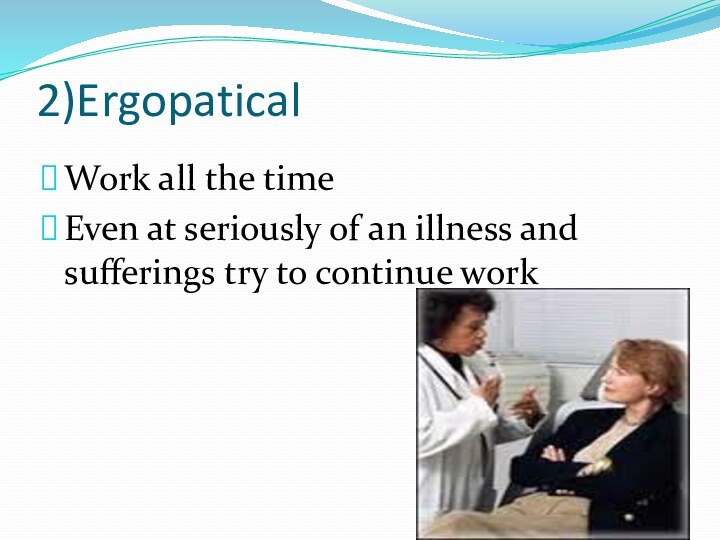- Главная
- Разное
- Бизнес и предпринимательство
- Образование
- Развлечения
- Государство
- Спорт
- Графика
- Культурология
- Еда и кулинария
- Лингвистика
- Религиоведение
- Черчение
- Физкультура
- ИЗО
- Психология
- Социология
- Английский язык
- Астрономия
- Алгебра
- Биология
- География
- Геометрия
- Детские презентации
- Информатика
- История
- Литература
- Маркетинг
- Математика
- Медицина
- Менеджмент
- Музыка
- МХК
- Немецкий язык
- ОБЖ
- Обществознание
- Окружающий мир
- Педагогика
- Русский язык
- Технология
- Физика
- Философия
- Химия
- Шаблоны, картинки для презентаций
- Экология
- Экономика
- Юриспруденция
Что такое findslide.org?
FindSlide.org - это сайт презентаций, докладов, шаблонов в формате PowerPoint.
Обратная связь
Email: Нажмите что бы посмотреть
Презентация на тему Kazakh national medical university named after s.d.asfendiyarov
Содержание
- 2. IdeaTo know how the patients react to
- 3. Psychological reactions of patients to a diseaseThe patient's feelingsThe general healthComplex combinations of perceptionEmotions
- 4. Types of the relation to an illness
- 5. 2)ErgopaticalWork all the timeEven at seriously of an illness and sufferings try to continue work
- 6. 3)AnozognozicalActive rejection of thought of an illnessNot to recognize an obvious illnessRefusal of observation and treatment
- 7. 4) DisturbingContinuous concernSearch of new ways of treatmentThirst of additional information on an illness
- 8. 5)Ipochondrical They want to tell about the
- 9. 6) NeuroticTantrumsImpatienceCan not to wait for simplification
- 10. 7) MelancholicDisbelief in effect of treatment A
- 11. 8)EuphoricThoughtless relation to the stateDisturbances of a regimen of treatment and trainingThe increased mood
- 12. 9) ApatheticPassive submission to procedures and treatmentLoss
- 13. 10)SensitivePhobia to become a burden for relatives
- 14. 11) Egocentric "Leaving in illness" is characteristicConstant desire to show the special situationDemands attention and care
- 15. 12) Paranoiac The confidence that illness –
- 16. Personal questionnairesEstablishment of primary contactTo greeting with
- 17. Questions Opento give to the patient the
- 18. Literature
- 19. Скачать презентацию
- 20. Похожие презентации
IdeaTo know how the patients react to the illnessTo recognize the patient conditionsTypes of questions for interview



















Слайд 3
Psychological reactions of patients to a disease
The patient's
feelings
The general health
Complex combinations of perception
Emotions
Слайд 4 Types of the relation to an illness by
A.Lichko and N.Ivanov
1)Harmonious:
sober assessment of the state
actively to
promote success of treatment
Слайд 5
2)Ergopatical
Work all the time
Even at seriously of an
illness and sufferings try to continue work
Слайд 6
3)Anozognozical
Active rejection of thought of an illness
Not to
recognize an obvious illness
Refusal of observation and treatment
Слайд 7
4) Disturbing
Continuous concern
Search of new ways of treatment
Thirst
of additional information on an illness
Слайд 8
5)Ipochondrical
They want to tell about the disease
to people around
Search of nonexistent diseases and sufferings
Combination of
desire to be treated and disbelief in success
Слайд 10
7) Melancholic
Disbelief in effect of treatment
A pessimistic
view on everything around
Active depressive statements up to suicidal
thoughts.
Слайд 11
8)Euphoric
Thoughtless relation to the state
Disturbances of a regimen
of treatment and training
The increased mood
Слайд 12
9) Apathetic
Passive submission to procedures and treatment
Loss of
interest in everything that excited earlier
Absolute indifference to the
destiny
Слайд 13
10)Sensitive
Phobia to become a burden for relatives due
to illness
Excessive sensitivity
Fears that people around will begin to
avoid
Слайд 14
11) Egocentric
"Leaving in illness" is characteristic
Constant desire
to show the special situation
Demands attention and care
Слайд 15
12) Paranoiac
The confidence that illness – result
of someone's evil intention is characteristic.
Extreme suspiciousness to medicine
and proceduresAspiration to attribute possible complications of treatment and side effects of medicine to negligence or to evil intention of doctors and the personnel





























